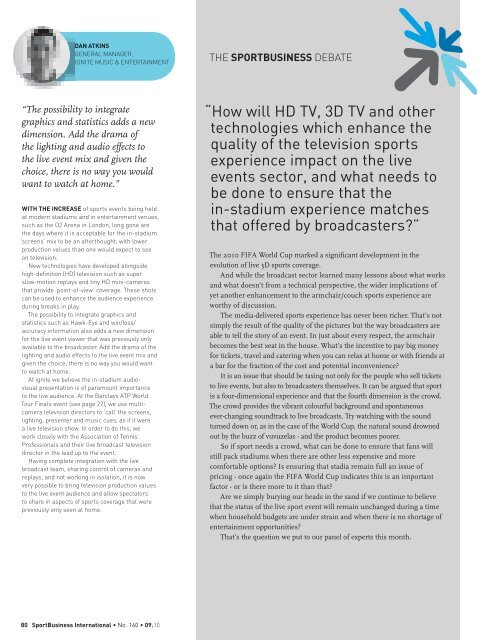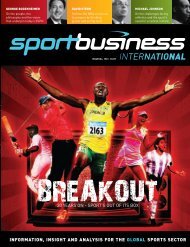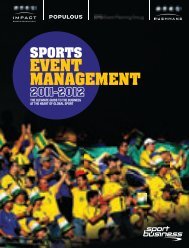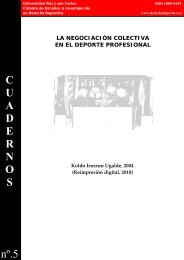4 - FIFA/CIES International University Network
4 - FIFA/CIES International University Network
4 - FIFA/CIES International University Network
You also want an ePaper? Increase the reach of your titles
YUMPU automatically turns print PDFs into web optimized ePapers that Google loves.
DAN ATKINS<br />
GENERAL MANAGER,<br />
IGNITE MUSIC & ENTERTAINMENT<br />
THE SPORTBUSINESS DEBATE<br />
“The possibility to integrate<br />
graphics and statistics adds a new<br />
dimension. Add the drama of<br />
the lighting and audio effects to<br />
the live event mix and given the<br />
choice, there is no way you would<br />
want to watch at home.”<br />
WITH THE INCREASE of sports events being held<br />
at modern stadiums and in entertainment venues,<br />
such as the O2 Arena in London, long gone are<br />
the days where it is acceptable for the in-stadium<br />
‘screens’ mix to be an afterthought, with lower<br />
production values than one would expect to see<br />
on television.<br />
New technologies have developed alongside<br />
high-definition (HD) television such as super<br />
slow-motion replays and tiny HD mini-cameras<br />
that provide ‘point-of-view’ coverage. These shots<br />
can be used to enhance the audience experience<br />
during breaks in play.<br />
The possibility to integrate graphics and<br />
statistics such as Hawk-Eye and win/loss/<br />
accuracy information also adds a new dimension<br />
for the live event viewer that was previously only<br />
available to the broadcaster. Add the drama of the<br />
lighting and audio effects to the live event mix and<br />
given the choice, there is no way you would want<br />
to watch at home.<br />
At ignite we believe the in-stadium audiovisual<br />
presentation is of paramount importance<br />
to the live audience. At the Barclays ATP World<br />
Tour Finals event (see page 27), we use multicamera<br />
television directors to ‘call’ the screens,<br />
lighting, presenter and music cues, as if it were<br />
a live television show. In order to do this, we<br />
work closely with the Association of Tennis<br />
Professionals and their live broadcast television<br />
director in the lead up to the event.<br />
Having complete integration with the live<br />
broadcast team, sharing control of cameras and<br />
replays, and not working in isolation, it is now<br />
very possible to bring television production values<br />
to the live event audience and allow spectators<br />
to share in aspects of sports coverage that were<br />
previously only seen at home.<br />
“How will HD TV, 3D TV and other<br />
technologies which enhance the<br />
quality of the television sports<br />
experience impact on the live<br />
events sector, and what needs to<br />
be done to ensure that the<br />
in-stadium experience matches<br />
that offered by broadcasters?”<br />
The 2010 <strong>FIFA</strong> World Cup marked a significant development in the<br />
evolution of live 3D sports coverage.<br />
And while the broadcast sector learned many lessons about what works<br />
and what doesn’t from a technical perspective, the wider implications of<br />
yet another enhancement to the armchair/couch sports experience are<br />
worthy of discussion.<br />
The media-delivered sports experience has never been richer. That’s not<br />
simply the result of the quality of the pictures but the way broadcasters are<br />
able to tell the story of an event. In just about every respect, the armchair<br />
becomes the best seat in the house. What’s the incentive to pay big money<br />
for tickets, travel and catering when you can relax at home or with friends at<br />
a bar for the fraction of the cost and potential inconvenience?<br />
It is an issue that should be taxing not only for the people who sell tickets<br />
to live events, but also to broadcasters themselves. It can be argued that sport<br />
is a four-dimensional experience and that the fourth dimension is the crowd.<br />
The crowd provides the vibrant colourful background and spontaneous<br />
ever-changing soundtrack to live broadcasts. Try watching with the sound<br />
turned down or, as in the case of the World Cup, the natural sound drowned<br />
out by the buzz of vuvuzelas - and the product becomes poorer.<br />
So if sport needs a crowd, what can be done to ensure that fans will<br />
still pack stadiums when there are other less expensive and more<br />
comfortable options? Is ensuring that stadia remain full an issue of<br />
pricing - once again the <strong>FIFA</strong> World Cup indicates this is an important<br />
factor - or is there more to it than that?<br />
Are we simply burying our heads in the sand if we continue to believe<br />
that the status of the live sport event will remain unchanged during a time<br />
when household budgets are under strain and when there is no shortage of<br />
entertainment opportunities?<br />
That’s the question we put to our panel of experts this month.<br />
80 SportBusiness <strong>International</strong> • No. 160 • 09.10

















